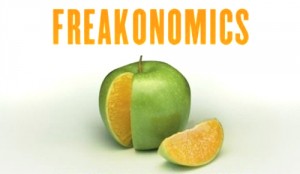 Have you read the book Freakonomics? Readers gushed over the logical beauties presented in Freakonomics; tying “broken windows and buildings left in disarray” to a rise in “gang violence”, and other examples tying together two otherwise un-connected events. I hear a similar tune in the following article. How might an effort to treat sick livestock cause $24,000,000,000 ($24 bln) in damage and killing 48,0000 people?
Have you read the book Freakonomics? Readers gushed over the logical beauties presented in Freakonomics; tying “broken windows and buildings left in disarray” to a rise in “gang violence”, and other examples tying together two otherwise un-connected events. I hear a similar tune in the following article. How might an effort to treat sick livestock cause $24,000,000,000 ($24 bln) in damage and killing 48,0000 people?
(The missing steps are the drugs given to livestock wiped out native vultures, leading to a rise in the wild dog population, leaving an estimated 48,000 people dead from dog attacks + rabies over the ensuing 14 year period.)
As I highlighted in my last article, species identification is important and a PCR machine is a key tool of DNA identification. Imagine if species identification were so easy that the monitoring of hundreds of species was commonplace. Might we be able to notice and understand trends more quickly? Here are a few of my favorite excerpts from Conniff’s “What are Species Worth? Putting a Price on Biodiversity“. (See the primary research on the cost of species decline)
For instance, Prochlorococcus is an ocean-dwelling genus of cyanobacteria and among the most abundant life forms on Earth. Why should we care? Because it produces about 20 percent of the oxygen we breathe — and yet until an MIT microbiologist named Sally Chisholm discovered it in 1986, Prochlorococcus was unknown. We need to understand in short that our lives depend on species most of us have never heard of — species we otherwise tend to shrug off as obscure, trivial, even undesirable.
Vultures, for instance. When we cause a species to go into decline, we almost never know — and hardly even stop to think about — what we might be losing in the process. In truth, it may be hard to think about, because the cascading effects of our actions are sometimes freakishly distant from the original cause. So in India in the early 1990s, farmers began using the anti-inflammatory drug diclofenac for the apparently worthy purpose of relieving pain and fever in their livestock. Unfortunately, vultures scavenging on livestock carcasses accumulated large quantities of the drug and promptly died of renal failure. Over a 14-year period, populations of three vulture species plummeted by between 96.8 and 99.9 percent.
Losing these efficient scavengers meant livestock carcasses often got left in the open to rot. It was one of those “ecosystem services” — manufacturing oxygen, soaking up carbon dioxide, preventing floods, taking out the garbage — that species generally provide unnoticed, until they stop. But the A diversity of species can help prevent the emergence of new diseases. impacts went well beyond the stench, according to a 2008 article in Ecological Economics. Moving into the niche vacated by the vultures, feral dog populations boomed by up to 9 million animals over the same period. Dog bites and the incidence of rabies in humans also increased, and the authors conservatively estimated that an additional 48,000 people died during the 14-year period as a result. Calculating the bottom-line worth of what we get from the natural world is notoriously difficult. But even pricing lives at a fraction of developed world values, the near-total loss of three insignificant vulture species has so far cost India an estimated $24 billion.
Read the full article: “What are Species Worth? Putting a Price on Biodiversity” by Richard Conniff
Supporting research, primary source: Counting the cost of vulture decline – An appraisal of human health and other benefits of vultures in India
The paper “Counting the cost of vulture decline – An appraisal of human health and other benefits of vultures in India” sites good evidence for a decline in the vulture population. Also, they present a reasonable evaluation of the human health and economic impact of an in the number of rabies incidences. However, the link between less vultures and more dogs seems to be very weak.
Sources are lacking and this link is “glossed” over. The author should have answered:
1) Do bugs, bacteria and other species of scavengers consume livestock carcasses? At what rate?
2) Are feral dogs affected by the same anti-inflammatory?
3) Dogs obviously cannot fly… does this impair their scavenging ability on possibly fenced range land?
Also, there is the age old argument of correlation does not prove causation. For example, did the decline in global pirate populations over the last two centuries cause the increase in global temperature over the same time period? They are correlated but obviously a causal link is non-existent. One must justify and validate a link, and rule out other possible causative agents to prove such a link.
In the same way, the authors show a decrease in vulture population and and increase in dog population. However the link sucks.
What are your thoughts?